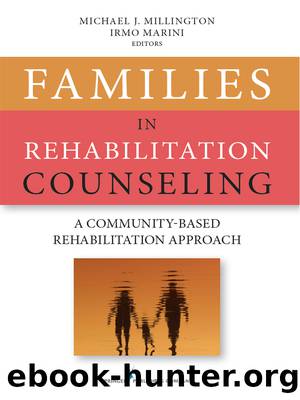Families in Rehabilitation Counseling by Marini Irmo;Millington Michael;Marini Irmo PhD DSc CRC CLCP;

Author:Marini, Irmo;Millington, Michael;Marini, Irmo, PhD, DSc, CRC, CLCP;
Language: eng
Format: epub
Publisher: Springer Publishing Company, Incorporated
Published: 2015-08-15T00:00:00+00:00
CHAPTER 8
Brain Injury and the Family: A Guide for Rehabilitation Counselors
CHARLES EDMUND DEGENEFFE AND GLORIA K. LEE
At least 1.7 million traumatic brain injuries (TBIs; Faul, Xu, Wald, & Coronado, 2010) and 795,000 nontraumatic injuries (e.g. strokes) occur every year (Roger et al., 2012). Prevalence rates are rising in Asia, Latin America, South America, the Caribbean, and Europe (see Julio César, Torres Norma, Lozano, & Zúñiga Carrasco, 2008; Puvanachandra & Hyder, 2008; Tagliaferri, Compagnone, Korsic, Servadei, & Kraus, 2006). The United States leads this trend with an average incidence rate of 58% of the populationâfive times the prevalence in India (Puvanachandra & Hyder, 2008) and at least double most other regions. Despite the growing burden on individuals, families, and communities (Baker, Tandy, & Dixon, 2002; Degeneffe & Olney, 2008), brain injury remains a âsilent epidemicâ (De Silva et al., 2008) that receives comparatively less public attention and funding than other disabilities and chronic illnesses.
Families of persons with brain injuries are thrown into the complicated and costly world of medical rehabilitation unprepared for the profound changes and challenges that face them (Bishop, Degeneffe, & Mast, 2006). The experience often forces families to redefine their roles and the nature of their supporting relationships. Spouses become permanent sources of instrumental and affective care (Degeneffe, 2001). The supervisory parental role extends past the time of childhood transition into adult independence (Sachs, 1991) and falters in an indeterminate future.
Rehabilitation counselors are often underresourced and underprepared to help the family with these complex TBI rehabilitation issues. Long-term community support services are difficult to find for the client and even harder for the family (Degeneffe et al., 2008). Formal training on supporting families following brain injury is not common in rehabilitation counseling education programs as it is not a recognized topic in the graduate-level canon (see Council on Rehabilitation Education, 2012). This paucity of knowledge coupled with rehabilitation counselingâs traditional focus on the individual makes the family as foreign to the profession as the profession is to the family. This is an unfortunate and hopefully transitory failing of practice, especially given the intensity of family involvement in rehabilitation efforts, its essential presence in long-term support, and the wealth of intimate client knowledge it possess.
This chapter provides a broad-based foundation for a rehabilitation counseling understanding of the family experience of brain injury through a biopsychosocial lens (see WHO, 2001). Two case studies will be used to illustrate the key points of discussion. Highlights include professional supports, planning for future caregiving, and an insiderâs perspective on family interactions with professionals. We review the psychosocial impact of brain injury on the family, its challenges with change, and postinjury family needs. The chapter concludes with a discussion of best-practice professional approaches toward supporting families that feature environmental resources, innovations, empowerment, and effective professionalâfamily collaborations.
Download
This site does not store any files on its server. We only index and link to content provided by other sites. Please contact the content providers to delete copyright contents if any and email us, we'll remove relevant links or contents immediately.
Adding Value to Policy Analysis and Advice by Claudia Scott; Karen Baehler(455)
Sociological Perspectives of Health and Illness by Constantinos N. Phellas(444)
Race and American Political Development by unknow(441)
American Government and Politics Today by Steffen W. Schmidt Mack C. Shelley Barbara A. Bardes(424)
Human and Global Security : An Exploration of Terms by Peter Stoett(424)
Control Of Oil - Hardback by Kayal(407)
Entrepreneurship Education and Training: The Issue of Effectiveness by Colette Henry Frances Hill Claire Leitch(364)
The Catholic Church and European State Formation, AD 1000-1500 by Jørgen Møller(355)
Materializing the Middle Passage by Jane Webster;(349)
The World According to China by Elizabeth C. Economy(343)
Left Is Not Woke by Susan Neiman(328)
Turkey's Relations with the West and the Turkic Republics: The Rise and Fall of the Turkish Model by Idris Bal(313)
Theories of Counseling and Psychotherapy: A Case Approach by Nancy L. Murdock(313)
Cross-Cultural Child Development for Social Workers by Lena Robinson(306)
Japan's Ainu Minority in Tokyo by Mark K. Watson(297)
Advances in Child Development and Behavior, Volume 37 by Patricia J. Bauer(295)
Laboratory Life by Bruno Latour(294)
Beyond Service: State Workers, Public Policy, and the Prospects for Democratic Administration by Greg McElligott(284)
The Oxford Handbook of Museum Archaeology by Stevenson Alice;(275)
